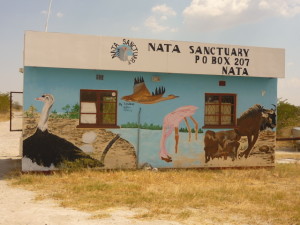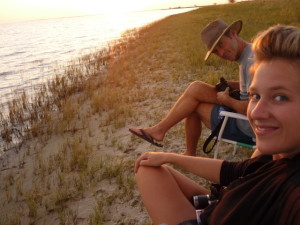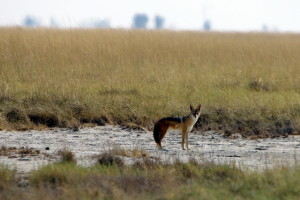We spent a full week in Francistown, the longest time I have spent in one campsite so far. There’s nothing of note for a tourist in Francistown, but even travelers sometimes need their downtime to catch up on laundry, internet, and R&R. Coming full circle is hard work!
 By the end of the week, I was raring to move north. The weather was getting cold fast and the sun was setting noticeably earlier each day – winter in southern Africa was upon us, already. Thankfully, Bruno had the foresight to install a high-tech heating system into the cell of the camper van, allowing us to adjust the temperature in the mornings and evenings. Thanks Bruno, you sure know how to keep a girl happy!
By the end of the week, I was raring to move north. The weather was getting cold fast and the sun was setting noticeably earlier each day – winter in southern Africa was upon us, already. Thankfully, Bruno had the foresight to install a high-tech heating system into the cell of the camper van, allowing us to adjust the temperature in the mornings and evenings. Thanks Bruno, you sure know how to keep a girl happy! And so we were ready to move north, to the Nata Bird Sanctuary, at the northeastern edge of the Sowa Pan. Last September, Bruno had taken me to the opposite edge of the same pan, some 200km away! (See blog entry, “Thirst” in September 2012 archives) At that time, the dry season was upon us, and the pan was looking as it does much of the time – white, salty, cracking earth devoid of plants, as far as the eye can see. (Google earth “Sowa Pan” to see what I mean – it’s quite the sight!). What a surprise, then, to see the pan at the end of a very, very rainy season – it had been transformed into a giant lake, with tons of little ponds all over the place. As luck would have it, this was the best time to come to the Nata Bird Sanctuary, for the water had attracted 165 different species of birds!
And so we were ready to move north, to the Nata Bird Sanctuary, at the northeastern edge of the Sowa Pan. Last September, Bruno had taken me to the opposite edge of the same pan, some 200km away! (See blog entry, “Thirst” in September 2012 archives) At that time, the dry season was upon us, and the pan was looking as it does much of the time – white, salty, cracking earth devoid of plants, as far as the eye can see. (Google earth “Sowa Pan” to see what I mean – it’s quite the sight!). What a surprise, then, to see the pan at the end of a very, very rainy season – it had been transformed into a giant lake, with tons of little ponds all over the place. As luck would have it, this was the best time to come to the Nata Bird Sanctuary, for the water had attracted 165 different species of birds! We spent the following three days within the sanctuary, and it was probably one of the highlights of my entire trip so far! The sanctuary, which is community-run, has a proper campsite near the highway entrance, but they gave us permission to camp anywhere within their grounds, “as long as we didn’t mind bush camping”.
We spent the following three days within the sanctuary, and it was probably one of the highlights of my entire trip so far! The sanctuary, which is community-run, has a proper campsite near the highway entrance, but they gave us permission to camp anywhere within their grounds, “as long as we didn’t mind bush camping”. “We don’t!”
So, we headed out to the pan and that, my friends, is where we stayed. Who wouldn’t want to spend their days by a salty lake, amid pelicans, flamingoes, ostriches, storks, and herons, as well as wildebeest, jackals, springbok and impala? Did I mention the spectacular sunsets and sunrises, the lulling of the waves, the salty, humid smell of the sea, or the nighttime cries of the jackal? Or better yet, the fact that we were the only ones within the grounds of the sanctuary between dusk and dawn?
 We awoke early each morning, the birds our alarm clock, urging us not to miss the sunrise. Cup of tea/coffee in hand, we would watch as the spectacularly large blazing ball rose before us, tinting everything pink (even the flamingoes, who were already quite pink!). Before its heat overwhelmed the entire landscape, we would take a walk around some of the smaller lagoons, observing the animals. A wildebeest took particular interest in us one morning, coming curiously close before wildly running off through one of the smaller lakes, still eyeing us suspiciously. Another morning, we watched a little egret nestle itself into the soft belly of a pink-backed pelican, trying to cuddle away the still-crisp morning air.
We awoke early each morning, the birds our alarm clock, urging us not to miss the sunrise. Cup of tea/coffee in hand, we would watch as the spectacularly large blazing ball rose before us, tinting everything pink (even the flamingoes, who were already quite pink!). Before its heat overwhelmed the entire landscape, we would take a walk around some of the smaller lagoons, observing the animals. A wildebeest took particular interest in us one morning, coming curiously close before wildly running off through one of the smaller lakes, still eyeing us suspiciously. Another morning, we watched a little egret nestle itself into the soft belly of a pink-backed pelican, trying to cuddle away the still-crisp morning air. 

 Afternoons, we’d find a picnic site with a view. Or, scared off by the afternoon heat, we’d withdraw to the shady “official” campsite and take a shower, fill up our water supplied, and plug into their electrical sockets. The resident squirrels would visit us, and we would naughtily feed them stale bread. Too cute to resist!
Afternoons, we’d find a picnic site with a view. Or, scared off by the afternoon heat, we’d withdraw to the shady “official” campsite and take a shower, fill up our water supplied, and plug into their electrical sockets. The resident squirrels would visit us, and we would naughtily feed them stale bread. Too cute to resist! Evenings were my favorite. As the heat slowly retreated, we’d venture back to our beloved pan. Often, there were safari vehicles from the local lodges, giving their guests a 2-hr glimpse of the pan at a hundred bucks a pop. I secretly relished the fact that, at dusk, they’d be gone, and Bruno and I would have this place to ourselves again. And for only $4 each! Until then, we would watch the flamingoes eating algae from the water, their beaks digging and scooping, their feet ever in motion. This algae is what gives the flamingoes their pink hue, and amazingly, each bird’s color is slightly different based on how much plankton they manage to consume. Watching the birds was mesmerizing, and especially beautiful when they would fly off in pink formation, with a setting sun behind them. The sunsets dusted a cool blueish-purple hue on the water, and an orangish-pink hue on the sand and grasses, completely transforming the otherwise bland, flat landscape. Bruno and I would stand transfixed, staring in awe at this life-giving ball, aware that we had seen it rise from the opposite end of our piece of earth some twelve hours before. The perpetual traveler, always in motion, giver of warmth, the sometimes-invisible, underlying force propelling all things. God?
Evenings were my favorite. As the heat slowly retreated, we’d venture back to our beloved pan. Often, there were safari vehicles from the local lodges, giving their guests a 2-hr glimpse of the pan at a hundred bucks a pop. I secretly relished the fact that, at dusk, they’d be gone, and Bruno and I would have this place to ourselves again. And for only $4 each! Until then, we would watch the flamingoes eating algae from the water, their beaks digging and scooping, their feet ever in motion. This algae is what gives the flamingoes their pink hue, and amazingly, each bird’s color is slightly different based on how much plankton they manage to consume. Watching the birds was mesmerizing, and especially beautiful when they would fly off in pink formation, with a setting sun behind them. The sunsets dusted a cool blueish-purple hue on the water, and an orangish-pink hue on the sand and grasses, completely transforming the otherwise bland, flat landscape. Bruno and I would stand transfixed, staring in awe at this life-giving ball, aware that we had seen it rise from the opposite end of our piece of earth some twelve hours before. The perpetual traveler, always in motion, giver of warmth, the sometimes-invisible, underlying force propelling all things. God?

As we dined by candlelight at the edge of the Sowa Lake, the crescent moon would descend, the jackal would start up his anguished cry, and then, silence. Black. Nothingness. The entire pan going to sleep at once. And that was our cue, we who are also a part of this pan, this piece of Nature. We who are also children of the Sun. We fell asleep each night peacefully, in anticipation of seeing our precious Sun-god rise again the next morning.
 The Nata Bird Sanctuary has existed for 20-odd years. The local people had the foresight to create this place, declaring that the value of this piece of nature was in its preservation, not its use. They relocated over 3,000 cows to neighboring lands, affirming that the birds and the antelope were of greater value to them. Now, the Nata Bird Sanctuary is one of three breeding grounds in all of Africa for greater and lesser flamingoes, and it is the largest of the three. These local Tswana people showed great foresight in doing so. What they have created is truly a sanctuary, not only for the birds, but for any nature-loving traveler seeking refuge and peace.
The Nata Bird Sanctuary has existed for 20-odd years. The local people had the foresight to create this place, declaring that the value of this piece of nature was in its preservation, not its use. They relocated over 3,000 cows to neighboring lands, affirming that the birds and the antelope were of greater value to them. Now, the Nata Bird Sanctuary is one of three breeding grounds in all of Africa for greater and lesser flamingoes, and it is the largest of the three. These local Tswana people showed great foresight in doing so. What they have created is truly a sanctuary, not only for the birds, but for any nature-loving traveler seeking refuge and peace. 

